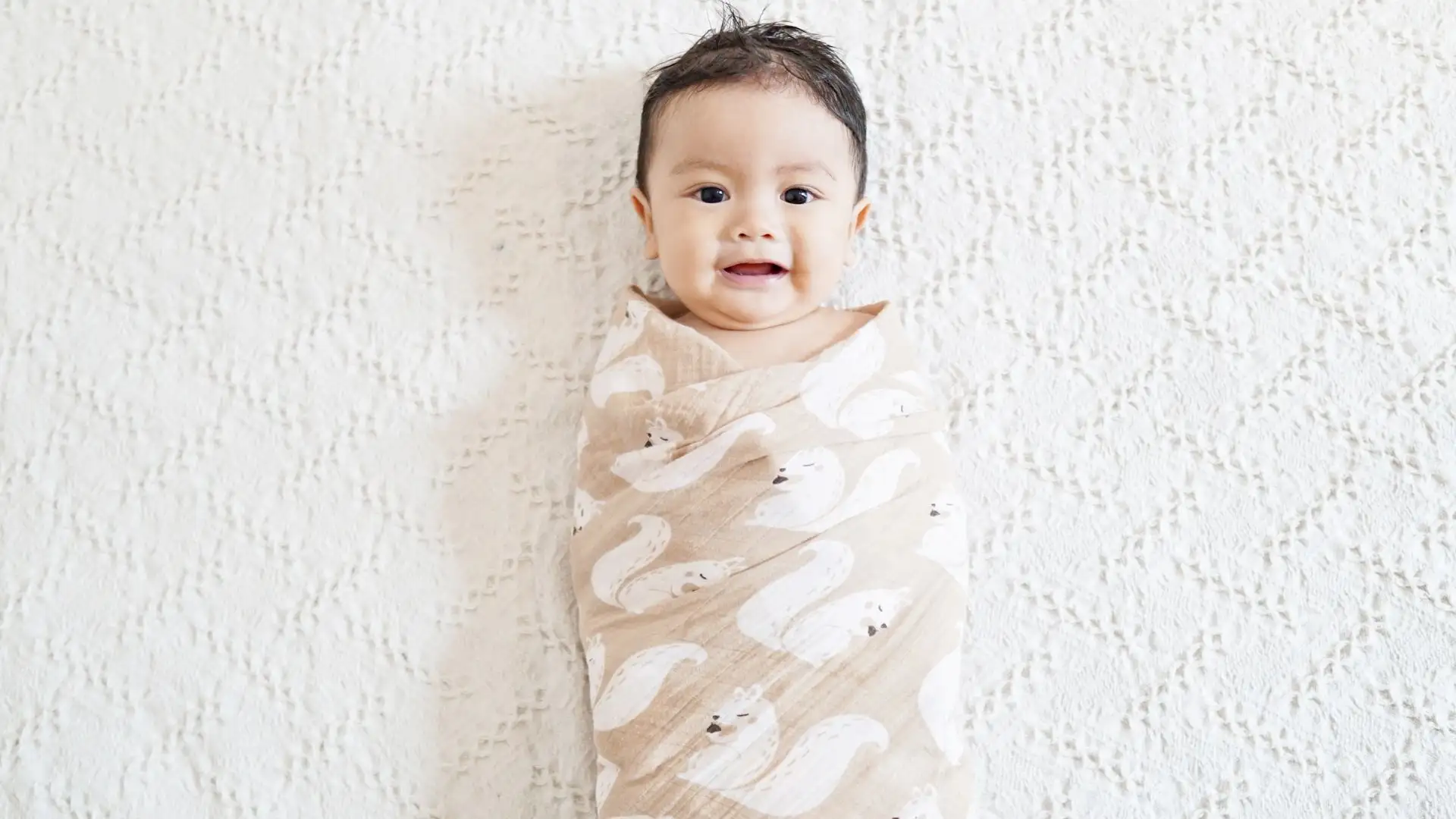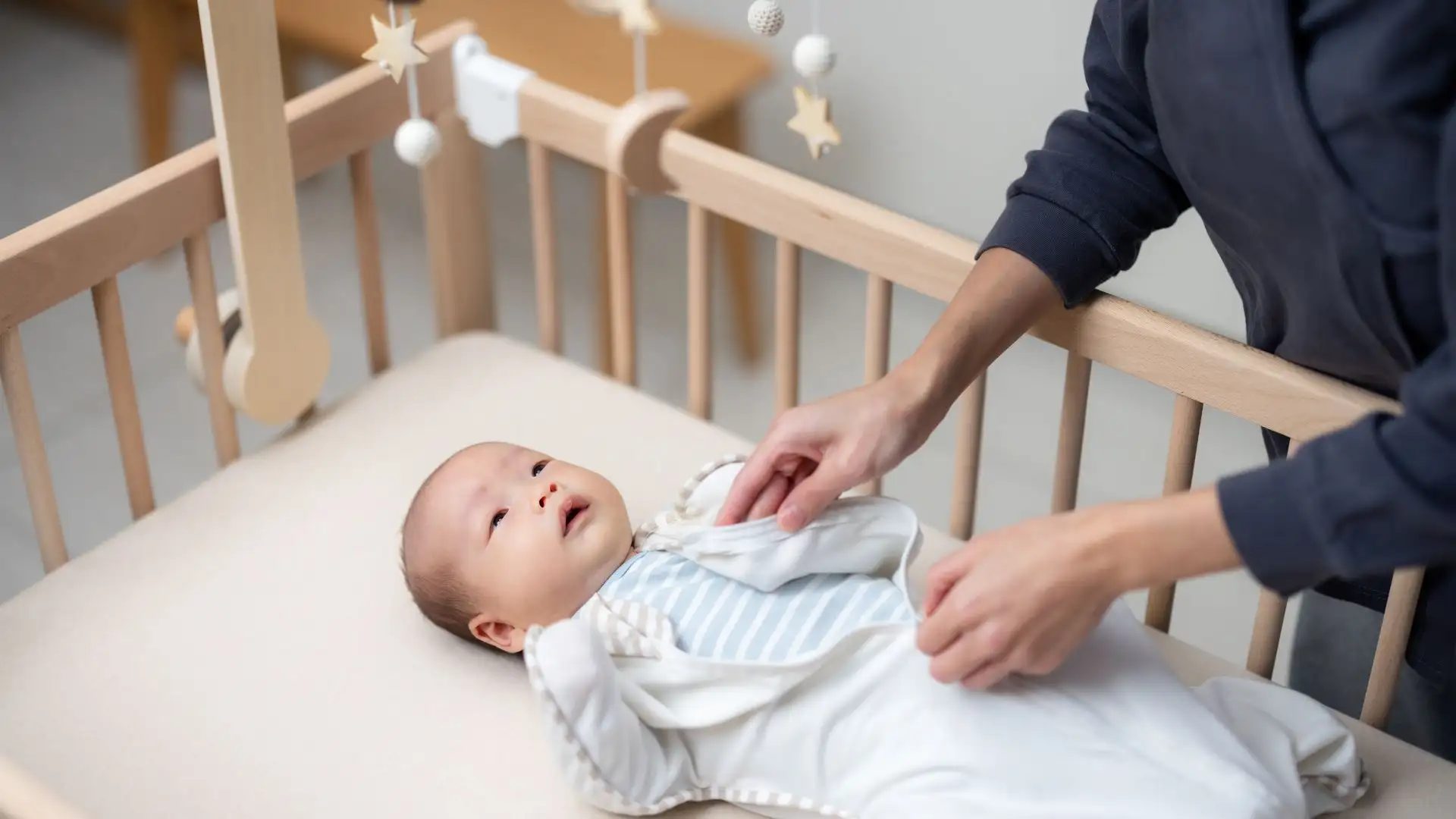You want your little one to feel safe and comfortable at home. Swaddling can help your Premature sleep better and feel calm, pediatric experts say this helps when you do it the right way.
Always place your baby on their back and make sure the blanket isn’t too tight, especially around the hips. If you wonder how to swaddle Premature baby correctly, remember to keep your baby’s face uncovered and watch for any signs of discomfort. Talk to your doctor if you have questions or concerns.
Key Takeaways
- Swaddling helps Premature babies feel safe. It helps them sleep longer. Swaddling keeps babies calm. It also lowers startle reflexes.
- Always use a thin, breathable blanket. Choose cotton or muslin. This stops your baby from getting too hot. It also keeps your baby comfortable.
- Put your baby on their back to sleep. Make sure their head is not covered. This keeps sleep safe. It also lowers the risk of SIDS.
- Let your baby’s hips and legs move freely. Their legs should stay bent in a natural way. This keeps their hips healthy. It also stops problems.
- Check if the swaddle is snug but not too tight. You should fit two or three fingers between the blanket and your baby’s chest. This makes sure your baby is safe and comfortable.
- Watch for signs your baby is too hot or uncomfortable. Look for fussiness, sweating, or fast breathing. Change the swaddle or room if needed.
- Stop swaddling when your baby starts to roll over. This helps avoid suffocation risks. It also helps your baby’s motor skills.
- If you are unsure about swaddling, ask your pediatrician. Always get help if you notice any problems.
Swaddling Benefits
Comfort and Sleep
Swaddling can really help your Premature feel better. Wrapping your baby snugly helps them feel safe, like in the womb.
This makes your baby calm and helps them relax. Some babies get startled easily, but swaddling can help with that.
You might ask if swaddling helps your baby sleep. Studies say it does! Here is what experts found:
- Prematures who are swaddled usually sleep longer and deeper than those who are not.
- One study showed swaddled babies slept about 183 minutes on average. Their sleep efficiency was 97.8%. Babies who were not swaddled had a sleep efficiency of 93.3%.
- Swaddling helps your baby wake up less, so they rest longer.
- Many parents see their babies are less fussy and more rested after swaddling.
- Some studies compare swaddling to “nesting.” Nesting uses rolled blankets to make a cozy spot. Nesting sometimes helps babies sleep even longer, but the difference is small.
- Swaddling does not always change your baby’s heart rate or breathing. But it helps most babies relax.
Tip: If your baby wakes up a lot or seems restless, try swaddling for naps and at night. You might see your baby sleep better and wake up happier.
Safety for Prematures
You want your baby to be safe, especially when they are so small. Swaddling, if done right, can help your Premature in many ways.
For example, one study looked at Prematures born before 34 weeks. It found swaddling during bottle feeding helped babies feed better. Swaddled babies did better on feeding tests.
Doctors did not see more problems like slow heart rate or low oxygen. This means swaddling can help your baby feed well without extra risks.
Swaddling also keeps your baby’s arms and legs from moving too much. This can stop them from waking themselves up. When you swaddle your Premature, you help them stay calm during feeding and sleep.
Always use a thin, breathable blanket. Make sure your baby’s hips can move easily. Safe swaddling gives your Premature comfort and helps you feel more sure when caring for them at home.
Getting Ready

Choosing a Blanket
Picking the right blanket makes swaddling safer and more comfortable for your Premature. You want a blanket that feels soft and gentle on your baby’s skin.
Look for a thin, breathable fabric like cotton or muslin. These materials help keep your baby from getting too hot. Avoid heavy or fuzzy blankets. They can trap heat and make your baby sweat.
Here’s a quick checklist for choosing a swaddle blanket:
- Size: A small blanket (about 30×30 inches) works best for Prematures.
- Material: Choose cotton, muslin, or another breathable fabric.
- Edges: Soft, finished edges prevent scratching.
- No decorations: Skip blankets with buttons, zippers, or loose threads.
Tip: Some stores sell special Premature swaddle blankets with Velcro or snaps. These can make swaddling easier, especially if you feel nervous about folding.
Preparing the Space
You want a calm, safe spot for swaddling. Pick a flat, clean surface like a changing table, crib, or even a firm bed. Make sure the area is free from clutter.
Keep anything sharp or small out of reach. Good lighting helps you see what you’re doing, especially at night.
Try these steps to set up your space:
- Lay out the swaddle blanket before you pick up your baby.
- Keep diapers, wipes, and any other supplies close by.
- Turn off loud music or TV. A quiet room helps your baby stay calm.
- Wash your hands and make sure the surface is clean.
Note: Never leave your baby alone on a high surface, even for a second. Always keep one hand on your baby if you need to reach for something.
Clean Hands
Your hands touch your baby’s delicate skin, so keeping them clean is important. Wash your hands with soap and warm water before you start. Dry them well. If you can’t get to a sink, use hand sanitizer.
Here’s a quick hand cleaning routine:
- Wet your hands with water.
- Use soap and scrub for at least 20 seconds.
- Rinse and dry with a clean towel.
You protect your baby from germs when you keep your hands clean. This small step makes a big difference, especially for Prematures who need extra care.
Reminder: Ask anyone who helps you swaddle to wash their hands, too. Your baby’s health comes first!
How to Swaddle Premature Baby Correctly
Blanket Setup
Getting the blanket ready is the first step in how to swaddle Premature baby correctly. Lay a thin, breathable blanket flat on a clean surface.
If you use a square blanket, fold down one corner to make a straight edge at the top. This gives you a spot to rest your baby’s shoulders.
Some parents like to use special swaddle blankets with Velcro or snaps. These can make things easier, but a simple cotton or muslin blanket works well, too.
Here’s a quick way to set up your blanket:
- Spread the blanket out flat, making sure there are no wrinkles.
- Fold the top corner down about 4-6 inches to create a straight edge.
- Place the blanket so the folded edge is at the top, closest to you.
Tip: Always use a thin, breathable blanket. This helps keep your baby from getting too hot.
Placing Baby
Now you’re ready to place your baby on the blanket. This step is important for safety and comfort. Lay your baby on their back, with their neck just above the folded edge. Make sure your baby’s head stays above the blanket so nothing covers their face.
Follow these steps:
- Gently pick up your baby and lay them face up on the blanket.
- Line up your baby’s shoulders with the folded edge.
- Keep your baby’s head and neck above the blanket at all times.
You want your baby’s body centered on the blanket. This makes wrapping easier and keeps the swaddle even on both sides. Always start with your baby on their back. This is the safest sleep position for Prematures.
Arms Position
When you learn how to swaddle a premature baby correctly, arm position matters a lot. Prematures often feel more secure with their arms bent up, close to their face or chest. This is different from full term babies, who usually have their arms down by their sides.
Here’s what you can do:
- Gently bend your baby’s arms so their hands are near their face or chest.
- Some babies like their arms tucked in, while others prefer one or both arms out. Watch your baby’s cues.
- Make sure the arms are not pressed straight down. Bent arms help your baby feel safe and let them self soothe.
Note: For Prematures, it’s safe to swaddle with bent arms until they reach their due date. This position feels natural and cozy for them.
If you use a swaddle with Velcro, check that it allows for arms up or bent arm positions. Always make sure your baby’s mouth and nose stay uncovered, and that the swaddle is snug but not too tight.
Wrapping Steps
Now that your baby is in position, you can start wrapping. Here’s a simple step-by-step guide for how to swaddle Premature baby correctly:
- Hold your baby’s left arm gently against their side, keeping it bent up near the face or chest.
- Take the left corner of the blanket and pull it across your baby’s body. Tuck the edge under their back, leaving the right arm free.
- Bring the bottom corner of the blanket up over your baby’s feet and right shoulder. Make sure there’s enough room for the legs to move and bend. Tuck any extra fabric behind your baby’s back.
- Hold your baby’s right arm in a bent position near the chest or face.
- Pull the right corner of the blanket across your baby’s body and tuck it underneath. The swaddle should feel snug but not tight.
- Double check that your baby’s hips and legs can move freely. The blanket should not force the legs straight down.
Always keep your baby’s face and neck uncovered. Place your baby on their back for every sleep.
If you use a swaddle with Velcro or snaps, follow the same steps. Make sure the arms stay in a natural, bent position and the hips have room to move.
Checking Snugness
You want your swaddle to feel secure, but not restrictive. Here’s how you can check if you’ve done it right:
| What to Check | What to Look For |
|---|---|
| Chest Tightness | You should fit two to three fingers between your baby’s chest and the swaddle. |
| Hip and Leg Movement | Your baby’s hips and legs should move up and out easily. |
| Breathing | Watch for normal, easy breathing. |
| Signs of Discomfort | Look for fussiness, rapid breathing, or skin color changes. |
| Temperature | Your baby should feel warm, not hot or sweaty. |
- If the swaddle feels too loose, your baby might wiggle out. If it’s too tight, your baby may have trouble breathing or moving their hips.
- Always check that your baby’s hands are in a comfortable position, like near the face or chest. This helps with self soothing and makes room for any medical tubes if needed.
If you’re ever unsure about how to swaddle Premature baby correctly, ask your nurse or doctor to show you.
Hip and Leg Safety
Protecting your baby’s hips is a big part of how to swaddle Premature baby correctly. You want to let the hips and legs move naturally. This helps prevent hip problems as your baby grows.
- Keep the blanket snug around the arms and chest, but loose around the hips and legs.
- Let your baby’s legs bend up and out at the hips. Don’t force the legs straight down or press them together.
- If you use a commercial swaddle, pick one with a roomy pouch for the legs.
- Your baby’s knees should stay slightly bent. The hips should rest in a natural, “frog like” position.
- Avoid wrapping the lower body tightly. This lowers the risk of hip dysplasia and keeps your baby comfortable.
Reminder: Always check your baby’s hips and legs after swaddling. If you notice any stiffness or your baby seems uncomfortable, loosen the swaddle and try again.
Swaddling can feel tricky at first, but with practice, you’ll get the hang of it. Remember, the goal is to keep your baby safe, comfortable, and able to move their hips and legs freely.
Temperature Check
Keeping your Premature at the right temperature is just as important as wrapping them up safely. Babies born early can’t control their body heat as well as full term babies. When you swaddle, you want your baby to feel cozy, but not too warm.
Here’s how you can check your baby’s temperature and make sure they stay comfortable:
- Feel your baby’s skin: Touch the back of their neck or chest. The skin should feel warm, not hot or sweaty. If your baby feels sweaty or their chest is damp, they might be too warm.
- Watch for signs of overheating: Look for flushed cheeks, rapid breathing, or fussiness. These can be clues that your baby is too hot.
- Dress your baby right: Use only a thin, breathable blanket for swaddling. Dress your baby in a light onesie or diaper underneath. Avoid hats or extra layers unless your doctor says otherwise.
- Use a skin temperature probe if needed: Sometimes, your doctor or nurse may recommend a skin temperature probe. You place this small sensor under your baby’s arm (the axilla). It stays in contact with the skin and helps you track your baby’s temperature over time. The probe can stay on while your baby is swaddled, so you don’t have to unwrap them to check.
- Check temperature trends: Don’t rely on just one reading. Watch how your baby’s temperature changes over time. If you notice a steady rise or drop, talk to your healthcare provider.
If you ever wonder how to swaddle Premature baby correctly and keep them at a safe temperature, remember this: Warm is good, hot is not. Your baby should feel snug, but never sweaty or overheated.
A good rule is to keep your baby’s room at a comfortable temperature for an adult in light clothing. If you feel too warm, your baby probably does too. Always check your baby’s skin and adjust the swaddle or clothing as needed.
Swaddling Safety

Hip Health
You want your baby to feel safe and comfortable, but you also need to protect their hips. Swaddling too tightly around the hips and legs can cause problems like hip dysplasia.
This happens when the hips do not develop the right way. Babies, especially Prematures, have soft joints that need room to move.
When you swaddle, always let your baby’s hips and legs bend up and out. This “froggy-leg” position is natural for newborns.
If you wrap the legs straight down or press them together, you put extra stress on the hip joints. Over time, this can lead to hip dislocation or other issues.
After swaddling, check if your baby’s knees can bend and move. If the blanket feels tight around the hips, loosen it a bit.
Here’s a quick checklist for hip safe swaddling:
- Keep the swaddle snug around the chest, but loose around the hips and legs.
- Let your baby’s legs move freely in a bent position.
- Avoid any swaddle that forces the legs straight or together.
Education about hip safe swaddling helps lower the risk of hip problems. You give your baby the best start when you let their hips move naturally.
Avoiding Overheating
Prematures babies cannot control their body temperature as well as older babies. Overheating is a real risk when swaddling.
Signs of overheating include warm or flushed skin, sweating, rapid heartbeat, fussiness, or even vomiting. You might notice your baby feels hot at the neck or ears.
To keep your baby safe, follow these steps:
- Keep the room temperature between 68 and 72°F (20 to 22°C).
- Dress your baby in light, breathable clothes under the swaddle.
- Use only a thin, breathable blanket for swaddling.
- Never use hats or extra layers during sleep.
- Keep your baby’s sleep area away from heaters or vents.
Note: If your baby feels sweaty or looks red, remove a layer and check again in a few minutes.
A simple way to check for overheating is to feel your baby’s neck or back. If it feels hot or damp, your baby may be too warm. Adjust the swaddle or room temperature as needed.
Safe Sleep Position
Safe sleep is one of the most important parts of swaddling. Always place your swaddled baby on their back for every nap and night sleep.
This position lowers the risk of Sudden Infant Death Syndrome (SIDS). Never put your baby to sleep on their side or stomach while swaddled.
Here are some key points for safe sleep:
- Always put your baby on their back to sleep.
- Remove all loose blankets, pillows, or toys from the crib.
- Use a firm, flat sleep surface like a crib or bassinet.
- Avoid weighted swaddles or blankets, as they can make it hard for your baby to breathe.
- Watch your baby to make sure they do not roll over while swaddled.
Alert: If your baby starts to roll, stop swaddling right away. Rolling while swaddled increases the risk of suffocation.
You help your Premature sleep safely by following these steps. Always check with your pediatrician if you have questions about swaddling or sleep safety.
Troubleshooting
Baby Resists Swaddle
Sometimes your Premature might fight the swaddle, even if you follow every step. This can feel frustrating, but it’s actually pretty common.
Babies resist swaddling for a few reasons:
- They might be in active sleep and move a lot.
- Overtiredness can make them fussy and harder to settle.
- As your baby grows, the startle reflex (Moro reflex) fades, so they may not need swaddling as much.
- The swaddle might feel itchy, too tight, or too warm.
You can help your baby accept the swaddle with a few simple tricks:
- Swaddle when both you and your baby feel calm. Take a few deep breaths together before you start.
- Watch for sleepy cues like yawning or rubbing eyes. Swaddle before your baby gets overtired.
- Make sure the blanket feels soft and fits well. Avoid anything scratchy or stiff.
- Try different swaddling products, like ones with Velcro or special closures, for an easier fit.
- Keep practicing. Some babies just need time to get used to the feeling.
- If your baby keeps breaking free or seems less startled, it might be time to stop swaddling.
Tip: Swaddling helps most Prematures relax and sleep better, but every baby is different. Trust your instincts and adjust as needed.
Escapes Swaddle
Does your baby wiggle out of the swaddle every time? You’re not alone! Many Prematures are little escape artists. Here’s how you can keep the swaddle secure:
- Make sure the swaddle is snug around the arms but loose at the hips and legs. You should fit two fingers between the blanket and your baby’s chest.
- Use a blanket that’s the right size—at least 44 inches square works best.
- Try swaddling with straight arms if your baby is close to their due date. For younger Prematures, bent arms are still okay.
- Fold the blanket into a V neck shape to avoid triggering the rooting reflex, which can make babies fuss and try to escape.
- Keep the room cool (68-72°F) and use a lightweight, breathable blanket.
- Consider a specialty swaddle with inner flaps or Velcro for extra security.
Always stop swaddling once your baby starts rolling over.
Signs of Discomfort
Your baby will let you know if something doesn’t feel right. Watch for these signs that your Premature feels uncomfortable in the swaddle:
- Kicking, punching, or crying every time you swaddle.
- Waking up more often at night after sleeping well before.
- Breaking out of the swaddle again and again.
- Rolling over or losing the startle reflex.
If you notice these signs, try these adjustments:
- Check your swaddling technique. Make sure the swaddle isn’t too tight or too loose.
- Let one arm out of the swaddle to help your baby adjust.
- Move to a sleepsack that allows more movement but still feels cozy.
- Keep the crib safe and comfy with a firm mattress and fitted sheet.
- Make sure the room stays at a comfortable temperature and use light fabrics.
Callout: If your baby keeps fighting the swaddle or starts rolling, it’s time to transition out of swaddling. Every baby is unique—follow your baby’s cues and talk to your doctor if you have concerns.
When to Stop Swaddling
Rolling Over
You might wonder when it’s time to stop swaddling your Premature. The answer is simple: as soon as your baby starts showing signs of rolling over, you need to stop swaddling.
Most babies begin to roll between 2 and 6 months old. Some Prematures may reach this milestone a little later, but you should watch closely for any signs.
Look for these clues:
- Your baby rolls from back to side or tummy during playtime.
- You see your baby pushing up with their hands during tummy time.
- The startle reflex fades, and your baby seems less jumpy.
- Your baby escapes from the swaddle more often.
Rolling over while swaddled can be dangerous. It can make it hard for your baby to breathe or move freely. Swaddling past this stage can also slow down your baby’s motor development.
If you notice any of these signs, it’s time to make a change. You can always check with your pediatrician if you feel unsure about your baby’s readiness.
Alert: Never put your baby to sleep swaddled if they can roll over. This increases the risk of suffocation.
Transition Tips
Transitioning out of the swaddle can feel like a big step, but you can make it easier for both you and your baby. Try a gradual approach to help your little one adjust to sleeping without the snug wrap.
Here’s a step-by-step way to help your Premature move out of swaddling:
- Start with one arm out. Use a transition bag or suit that lets you unzip one arm at a time. This gives your baby a chance to get used to having an arm free while still feeling secure.
- Move to both arms out. Once your baby sleeps well with one arm out, unzip the other arm. Now your baby can move both arms freely.
- Try legs out. Some transition suits let you free your baby’s legs next. This helps your baby practice hip healthy movement and get used to more freedom.
- Switch to a sleep bag. When your baby sleeps comfortably with arms and legs out, stop using the swaddle. A sleep bag or wearable blanket keeps your baby cozy and safe.
- Alternate if needed. If your baby struggles, you can switch between swaddling and sleeping freely for a few nights. This helps your baby adjust at their own pace.
You can also help by keeping a consistent bedtime routine. Use white noise if it helps your baby relax, but keep the volume low. Watch your baby’s cues and celebrate small wins along the way.
Tip: Every baby is different. Some adjust quickly, while others need more time. Stay patient and give lots of cuddles during the transition.
If you ever feel unsure, reach out to your pediatrician. They can guide you based on your baby’s development and needs. Your support and attention make this transition smoother for your little one.
When to Ask for Help
Pediatrician Advice
You might feel unsure about swaddling your Premature at home. That’s normal. Pediatricians answer lots of questions from parents just like you. They want to help you keep your baby safe and comfortable.
Here are some of the most common things pediatricians talk about when it comes to swaddling Prematures:
- Overheating is a big concern. Swaddling can make your baby too warm, which raises the risk of Sudden Infant Death Syndrome (SIDS). Always check your baby’s chest or the back of their neck. If your baby feels hot or sweaty, remove a layer.
- Use only light, breathable blankets. Heavy or thick blankets trap heat and can make your baby overheat.
- Always follow safe sleep guidelines. Put your baby on their back to sleep. Use a separate sleep space, like a crib or bassinet. Keep loose bedding, pillows, and toys out of the crib.
- Hip health matters. Swaddling too tightly around the legs can cause hip problems. Make sure your baby’s legs can bend and move freely.
- Watch for signs of respiratory distress. Swaddling too tightly around the chest can make it hard for your baby to breathe.
If you ever feel unsure, call your pediatrician. No question is too small when it comes to your baby’s safety.
Pediatricians also remind you to stop swaddling once your baby starts trying to roll over. Rolling while swaddled can be dangerous. If you notice your baby trying to turn, it’s time to transition out of the swaddle.
Special Concerns
Sometimes, you might notice something that doesn’t seem right. Maybe your baby seems uncomfortable, cries more than usual, or has trouble breathing. Trust your instincts. You know your baby best.
Reach out to your healthcare provider if you notice any of these:
- Your baby feels hot, sweaty, or has flushed skin, even after you adjust the blanket.
- You see signs of hip stiffness or your baby’s legs seem stuck straight.
- Your baby has trouble breathing, wheezes, or breathes very fast.
- Your baby develops a rash or skin irritation where the blanket touches.
- Your baby starts rolling over or tries to turn while swaddled.
- You feel unsure about your swaddling technique or your baby’s comfort.
Alert: If your baby ever has trouble breathing or turns blue around the lips or face, call emergency services right away.
You might also have special concerns if your baby was born very early or has medical needs. Some Prematures need extra monitoring or special swaddling techniques. Your doctor or nurse can show you what works best for your baby’s unique situation.
Remember, you’re not alone. Many parents have questions about swaddling. Your healthcare team wants to support you and your baby every step of the way. Don’t hesitate to ask for help whenever you need it.
Swaddling your Premature at home can feel overwhelming, but you’ve got this! Remember these key tips:
- Use breathable cotton or muslin to keep your baby cool.
- Let your baby’s legs bend and move for healthy hips.
- Always place your baby on their back to sleep.
- Stop swaddling when your baby starts to roll over.
Watch your baby for signs of discomfort or overheating. If you ever feel unsure, reach out to your pediatrician. You’re doing an amazing job—trust yourself and your instincts!
FAQ
How long can you safely swaddle a Premature each day?
You can swaddle your Premature for naps and nighttime sleep. Give your baby breaks during awake times so they can stretch and move. Always watch for signs of discomfort or overheating.
Can you swaddle a Premature with medical tubes or monitors?
Yes, you can swaddle a Premature with tubes or monitors. Make sure the swaddle does not press on any medical equipment. Ask your nurse or doctor for tips on safe wrapping around wires.
What if your Premature hates being swaddled?
Some Prematures do not like swaddling. Try leaving one arm out or using a sleep sack. Watch your baby’s cues. If your baby stays fussy, it may be time to stop swaddling.
Is it okay to use a swaddle with Velcro or zippers?
You can use swaddles with Velcro or zippers. These can make swaddling easier and faster. Always check that the fit is snug but not tight. Make sure your baby’s hips and legs can move freely.
How do you know if your Premature is too hot while swaddled?
Feel your baby’s neck or chest. If the skin feels hot or sweaty, your baby may be too warm. Remove a layer or loosen the swaddle. Keep the room at a comfortable temperature.
Can you breastfeed or bottle feed while your baby is swaddled?
You can feed your Premature while swaddled. Some babies eat better when wrapped. Make sure the swaddle does not cover your baby’s face. Watch for signs of discomfort during feeding.
What should you do if your preemie rolls over while swaddled?
Stop swaddling right away if your baby rolls over. Rolling while swaddled is not safe. Move your baby to a sleep sack or wearable blanket for safe sleep.



